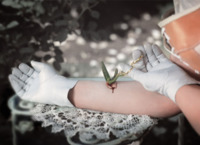Items
Site
The Medicine Chest
keywords is exactly
departments
-

Resonance
"The revelation of my object-study that the chest was a lacuna in terms of local botanical medicinal remedies and practices served as inspiration for the first department I approached. By engaging with insiders of the Department of Biological Sciences, I reasoned that I could supplement the chest’s Western content with local botanical knowledge. As the first viewing session, it was also the one that initiated the weakening of the chest’s imperial viral load through an inoculation of additional meaning – a treatment with a surprising side-effect. On presenting the chest to other disciplinary insiders afterwards (to Pathology and the College of Music, for example), I noticed characteristics that also resonated with the field of botany within these disciplines and their collections. These botanical resonances accrued as my disciplinary engagements increased and diversified, leading me to embrace this side-effect and to use botany as the central theme of my exhibition. The resonances generated in the different departmental viewing sessions resulted in new links with the chest but also in connections surfacing between disciplines such as zoology, dermatology, pharmacology and sound studies, for example. I drew on these visits and their outcomes to create a range of artworks that materialised the inoculation of the chest by manifesting how intersecting with diverse fields expanded its meaning, and I sourced objects from the collections that encouraged new interpretations" (Liebenberg 2021: 244 - 246). -

Smallpox
"In Kimberley in 1883-4, several leading doctors with links to the diamond-mining industry publicly denied the presence of smallpox among migrant workers, instead diagnosing them as suffering from a rare skin disease. They appear to have done so lest admitting that the dreaded smallpox was raging, which would have affected the supply of labour and materiel and thereby interrupting mining operations. Led by Cecil Rhodes’s friend, Dr Leander Starr Jameson, measures to curb the epidemic were sporadic or, in the mining compounds, non-existent, and cases topped 2000, with mortality at 3.5 per cent of the population. Only when the colonial government eventually called in external doctors to diagnose the disease, was the cover-up terminated and vaccination, fumigation and isolation vigorously pursued. The conspiracy of denial, by retarding action and sowing doubt about the need to be vaccinated, had been responsible for no small percentage of the 700 deaths in the town" (Phillips 2012: 32-33). -

Kimberlite
"UCT was founded in 1829 as the South African College, a high school for boys. The College had a small tertiary-education facility that grew substantially after 1880, when the discovery of gold and diamonds in the north – and the resulting demand for skills in mining – gave it the financial boost it needed to grow. The College developed into a fully fledged university during the period 1880 to 1900, thanks to increased funding from private sources and the government. During these years, the College built its first dedicated science laboratories, and started the departments of mineralogy and geology to meet the need for skilled personnel in the country's emerging diamond and gold-mining industries (Ritchie 1918: 495-496)".


